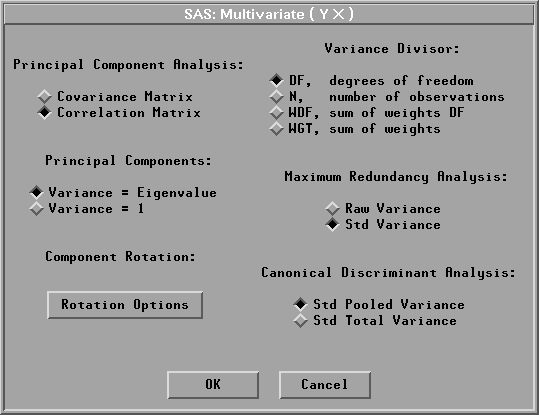| Multivariate Analyses |
Method
Observations with missing values for any of the Partial variables are not used. Observations with Weight or Freq values that are missing or that are less than or equal to 0 are not used. Only the integer part of Freq values is used.
Observations with missing values for Y or X variables are not used in the analysis except for the computation of pairwise correlations. Pairwise correlations are computed from all observations that have nonmissing values for any pair of variables.
The following notation is used in this chapter:
- n is the number of nonmissing observations.
- np, ny, and nx are the numbers of Partial, Y, and X variables.
- d is the variance divisor.
- wi is the ith observation weight (values of the Weight variable).
- yi and xi are the ith observed nonmissing Y and X vectors.
 and
and  are the sample mean vectors,
are the sample mean vectors,  ,
, .
.
The sums of squares and crossproducts of the variables are
The corrected sums of squares and crossproducts of the variables are
If you select a Weight variable, the sample mean vectors are
![]()
![]()
The sums of squares and crossproducts with a Weight variable are
The corrected sums of squares and crossproducts with a Weight variable are
The covariance matrices are computed as
Syy = Cyy / d Syx = Cyx / d Sxx = Cxx / d
To view or change the variance divisor d used in the calculation of variances and covariances, or to view or change other method options in the multivariate analysis, click on the Method button from the variables dialog to display the method options dialog.

Figure 40.3: Multivariate Method Options Dialog
The variance divisor d is defined as
| for vardef=DF, degrees of freedom | ||
| for vardef=N, number of observations | ||
| for vardef=WDF, sum of weights minus number of partial variables minus 1 | ||
| for vardef=WGT, sum of weights |
By default, SAS/INSIGHT software uses DF, degrees of freedom.
The correlation matrices Ryy, Ryx, and Rxx, containing the Pearson product-moment correlations of the variables, are derived by scaling their corresponding covariance matrices:
- Ryy = Dyy-1 Syy Dyy-1
- Ryx = Dyy-1 Syx Dxx-1
- Rxx = Dxx-1 Sxx Dxx-1
where Dyy and Dxx are diagonal matrices whose diagonal elements are the square roots of the diagonal elements of Syy and Sxx:
- Dyy = (diag( Syy))1/2
- Dxx = (diag( Sxx))1/2
Principal Component Analysis
Principal Component Rotation
Canonical Correlation Analysis
Maximum Redundancy Analysis
Canonical Discriminant Analysis
Copyright © 2007 by SAS Institute Inc., Cary, NC, USA. All rights reserved.